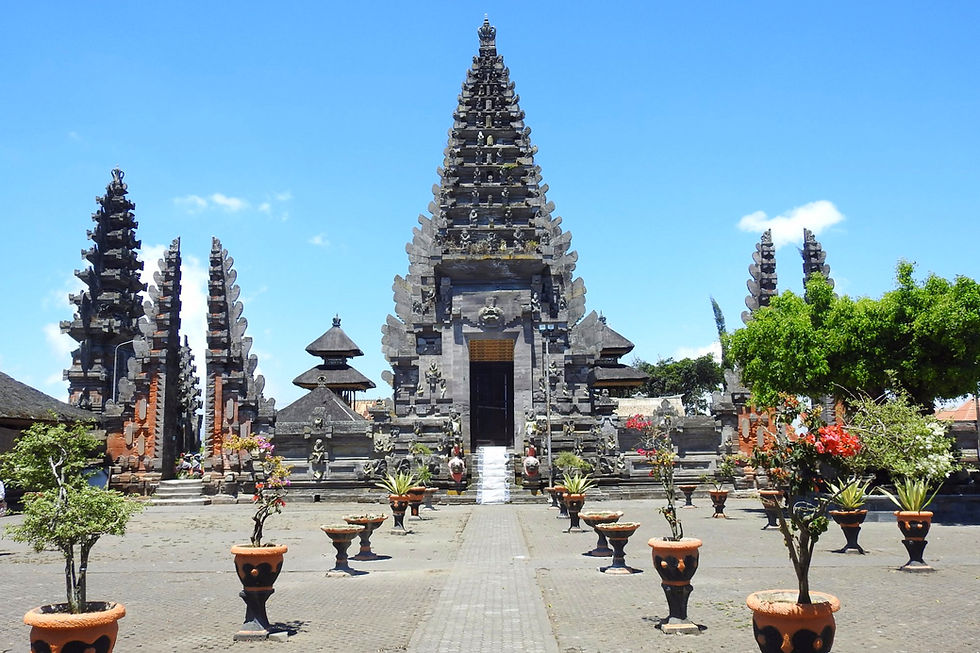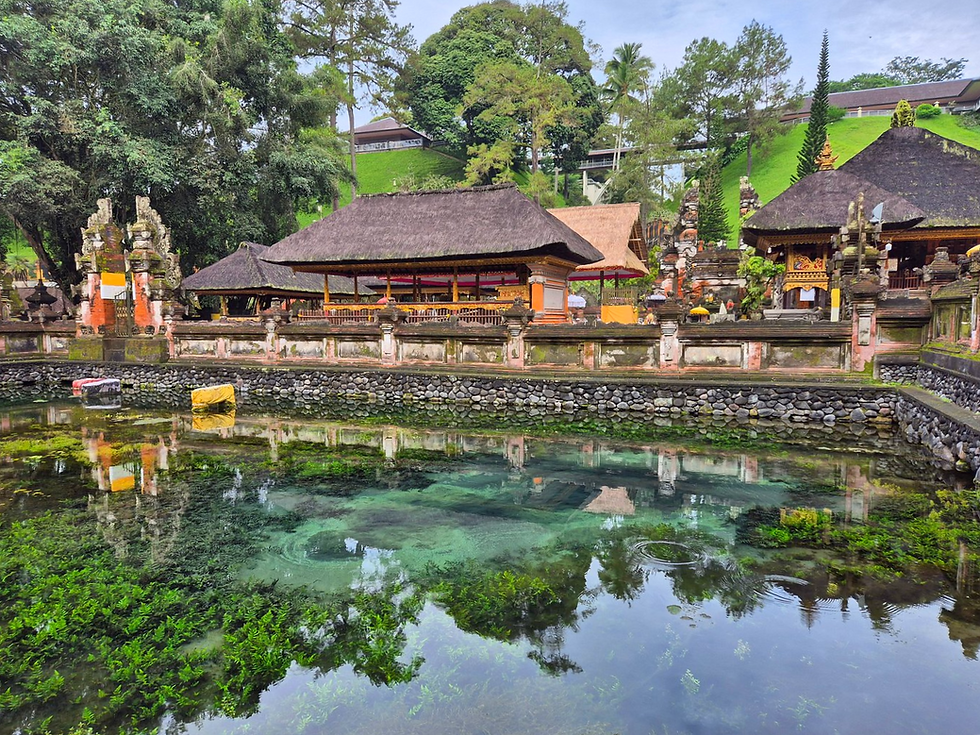Pura Ulun Danu Batur - The Temple of Ash and Mercy
- Shannon
- Sep 16
- 5 min read
A Temple Above the Clouds
First established in the 17th century, Pura Batur is one of Bali’s most venerated temples, second only to Pura Besakih on the sacred slopes of Mount Agung. Perched at roughly 900 metres above sea level, this mountain sanctuary overlooks the dramatic caldera of Mount Batur, an active volcano steeped in myth and raw geological power. The temple is dedicated to Dewi Danu, the goddess of Lake Batur, Bali’s largest crater lake and plays a crucial role in maintaining spiritual equilibrium and agricultural prosperity across the island. Revered as a guardian of water, the essence of Balinese life, Pura Batur forms a spiritual triad with Pura Besakih and Pura Ulun Danu Beratan, linking the elements of fire, water and earth in a cosmic balance.

Before the devastating eruption of 1917, Pura Batur stood at the base of Mount Batur, alongside the village of Karang Anyar. When the volcano erupted, rivers of lava tore down its slopes, engulfing the village and nearly erasing the temple itself. Yet, in what many saw as a divine sign, the lava stopped just short of Pura Batur’s gates. This miracle strengthened the villagers' belief in the protective power of the gods and despite the destruction around them, they chose to remain in the shadow of the volcano, their faith deepened by the narrow escape. That faith was put to the ultimate test on April 21st 1926, when Mount Batur erupted again, this time with catastrophic force. Molten rock swallowed homes and altars and as the village fell, residents risked everything to save sacred heirlooms, effigies and relics. Incredibly, the temple’s most revered structure, the 11-tiered meru dedicated to the goddess of Lake Batur, emerged untouched. Seen as yet another divine message, this survival became the spiritual anchor for the community. Forced to abandon their village, the survivors relocated to a higher point along the caldera’s southwest rim. There, with devotion and care, they rebuilt the temple stone by stone, in honour of the goddess who had both destroyed and protected them.
Today, the temple complex spans a grand scale, comprising nine major temples and over 280 individual shrines and pavilions. Each is adorned with vibrant carvings and offerings, dedicated to various deities governing the island's most vital domains such as agriculture, arts, fertility and sacred waters. Among its most striking features are the three 9-tiered meru towers, rising like black-lava spires into the mist. These are devoted to Mount Batur itself, Mount Abang, Batur’s spiritual counterpart and Ida Batara Dalem Waturenggong, a deified king of the Gelgel dynasty whose rule marked the golden age of Balinese Hinduism. The architecture is charged with symbolism, each level of the pagodas representing layers of the cosmos in Balinese cosmology.

A unique shrine within the temple honours Kang Cing Wie, a Chinese noblewoman entwined in one of Bali’s most haunting legends. According to 12th-century lore, she was the wife of King Sri Jaya Pangus, a beloved ruler whose reign bridged two cultures. The royal couple, though deeply in love, were unable to conceive a child. Driven by spiritual despair, the king set off on a pilgrimage across the seas, eventually reaching Lake Batur, where he was ensnared by the ethereal Dewi Danu. She seduced the king and together they bore a son. Years passed and Queen Kang Ching Wie, still waiting, embarked on her own quest to find him. When she discovered his betrayal, a supernatural conflict erupted between the earthly queen and the goddess. The battle ended in fiery tragedy. Both the king and queen were consumed by flames, their bodies turned to stone. Their story endures in the Barong Landung, towering effigies representing their spirits in temple processions and ceremonial dance.
But this temple’s lore doesn’t end with royal sorrow. Local whispers speak of nights when a mist coils around the meru towers and strange lights flicker over Lake Batur. Some say these are the spirits of the displaced, still mourning their lost homes after the 1926 eruption. Others believe they are the restless souls of Kang Cing Wie and Sri Jaya Pangus, trapped between worlds, reliving their final moments in a ghostly embrace. During full moon ceremonies, it’s said that the air around her shrine feels inexplicably cold and offerings sometimes go missing by morning. Priests advise visitors to step lightly and speak gently near her shrine, especially women, who are believed to be more sensitive to the queen’s lingering sorrow.

Pura Ulun Danu Batur - The Temple of Ash and Mercy
Though reborn in the shadow of destruction, Pura Batur stands today as a place of extraordinary resilience and spiritual gravity. Its stone guardians, draped in checkered cloth, serve not only as protectors but as storytellers, silent keepers of centuries of faith, fury and folklore. The temple is not merely a structure, it’s a living manuscript carved into the mountainside, where nature, history and the unseen world converge. In every offering, every drumbeat, every whisper of incense smoke, the pulse of Bali’s mystical heart continues to beat. It was listed as a UNESCO World Heritage Site in 2012.
🗺️ Location
Jalan Raya Kintamani, Batur Sel, Kintamani, Bangli Regency, Bali, Indonesia
🚆 How to get there
Pura Ulun Danu Batur is located in the Kintamani region, perched high on the southwestern edge of Mount Batur’s caldera. The most common approach is from the south, with two main routes leading from Ubud—each taking around 45 minutes. The temple is also accessible from Besakih, about an hour’s drive away, and from Bangli, which takes approximately 30 minutes. Travelers coming from the north can reach the site easily via the coastal road that runs east of Singaraja, with a journey time of about one hour. If you're staying in the southern tourist hubs like Kuta or Denpasar, expect a scenic two hour drive up into the mountains to reach Kintamani and the temple. Organising a private driver for the day will be your easiest option, there are plenty of sites to see along the way. A driver for the day with cost between 600,000 - 800,000 IDR per car.
⭐ Attraction Info
Pura Ulun Danu Batur is open daily from 8am to 5pm. Entry costs 35,000 IDR on weekdays and 50,000 IDR on weekends. As with all Balinese temples, visitors are required to wear a sarong and a sash tied around the waist as a sign of respect. If you don't have your own, these can be rented near the temple gates for around 20,000 IDR. However, it's worth noting that many travellers have reported uncomfortable encounters with overly aggressive locals near the entrance. Scams and pressure tactics to extract extra money are, unfortunately, common in this area. To avoid unnecessary interaction, it's highly recommended to bring your own sarong and stay focused as you make your way to the temple. Avoid engaging in conversation or eye contact with persistent vendors. Once inside, you'll be able to enjoy the temple’s serenity and spiritual atmosphere without disturbance.




















